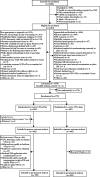Comparison of effect of CTG + STan with CTG alone on emergency Cesarean section rate: STan Australian Randomized controlled Trial (START)
- PMID: 37289946
- PMCID: PMC10946943
- DOI: 10.1002/uog.26279
Comparison of effect of CTG + STan with CTG alone on emergency Cesarean section rate: STan Australian Randomized controlled Trial (START)
Abstract
Objective: To investigate whether use of ST analysis of the fetal electrocardiogram (STan) as an adjunct to continuous cardiotocography (CTG) reduces the rate of emergency Cesarean section (EmCS) compared with CTG alone.
Methods: This was a randomized controlled trial of patients with a singleton fetus in cephalic presentation at ≥ 36 weeks' gestation, requiring continuous electronic fetal monitoring during labor at a tertiary maternity hospital in Adelaide, Australia, between January 2018 and July 2021. Participants were randomized to undergo CTG + STan or CTG alone. The calculated sample size was 1818 participants. The primary outcome was EmCS. Secondary outcomes included metabolic acidosis, a composite adverse perinatal outcome, and other maternal and neonatal morbidity and safety outcomes.
Results: The present study enrolled 970 women, of whom 967 were included in the primary analysis. EmCS occurred in 107/482 (22.2%) deliveries in the CTG + STan arm and in 107/485 (22.1%) in the CTG arm (adjusted relative risk, 1.02 (95% CI, 0.81-1.27); P = 0.89). There was no difference in the rate of adverse maternal or neonatal outcomes between arms.
Conclusions: The addition of STan as an adjunct to continuous CTG did not reduce the EmCS rate. The smaller-than-anticipated sample size meant that this study was underpowered to detect absolute differences of ≤ 5% and, therefore, this negative finding could be due to a Type-2 error. © 2023 The Authors. Ultrasound in Obstetrics & Gynecology published by John Wiley & Sons Ltd on behalf of International Society of Ultrasound in Obstetrics and Gynecology.
Keywords: CTG; Cesarean section; RCT; ST analysis; STan; cardiotocography; fetal ECG; fetal electrocardiography; intrapartum fetal monitoring; randomized controlled trial.
© 2023 The Authors. Ultrasound in Obstetrics & Gynecology published by John Wiley & Sons Ltd on behalf of International Society of Ultrasound in Obstetrics and Gynecology.
Figures

Similar articles
-
Comparing the effect of STan (cardiotocographic electronic fetal monitoring (CTG) plus analysis of the ST segment of the fetal electrocardiogram) with CTG alone on emergency caesarean section rates: study protocol for the STan Australian Randomised controlled Trial (START).Trials. 2019 Aug 29;20(1):539. doi: 10.1186/s13063-019-3640-9. Trials. 2019. PMID: 31464638 Free PMC article.
-
Psychosocial outcomes from one cohort participating in the STan Australian Randomised controlled Trial (START).Birth. 2024 Sep;51(3):595-601. doi: 10.1111/birt.12815. Epub 2024 Feb 2. Birth. 2024. PMID: 38305668 Clinical Trial.
-
Cardiotocography combined with ST analysis versus cardiotocography combined with fetal blood sampling in deliveries with abnormal CTG: a randomized trial.Arch Gynecol Obstet. 2023 Jun;307(6):1771-1780. doi: 10.1007/s00404-022-06649-3. Epub 2022 Jun 14. Arch Gynecol Obstet. 2023. PMID: 35701639 Clinical Trial.
-
Does ST analysis have a place in electronic fetal monitoring?J Matern Fetal Neonatal Med. 2017 Mar;30(5):520-524. doi: 10.1080/14767058.2016.1181169. Epub 2016 May 16. J Matern Fetal Neonatal Med. 2017. PMID: 27098566 Review.
-
Effectiveness of intrapartum fetal surveillance to improve maternal and neonatal outcomes: a systematic review and network meta-analysis.CMAJ. 2021 Apr 6;193(14):E468-E477. doi: 10.1503/cmaj.202538. CMAJ. 2021. PMID: 33824144 Free PMC article.
Cited by
-
ST waveform analysis vs cardiotocography alone for intrapartum fetal monitoring: An updated systematic review and meta-analysis of randomized trials.Acta Obstet Gynecol Scand. 2024 Mar;103(3):437-448. doi: 10.1111/aogs.14752. Epub 2023 Dec 13. Acta Obstet Gynecol Scand. 2024. PMID: 38093630 Free PMC article.
References
-
- Organisation for Economic Co‐operation and Development (OECD) . Health at a glance 2019: OECD Indicators. OECD Publishing, Paris. 10.1787/4dd50c09-en. - DOI
-
- Alfirevic Z, Devane D, Gyte GM, Cuthbert A. Continuous cardiotocography (CTG) as a form of electronic fetal monitoring (EFM) for fetal assessment during labor. Cochrane Database Sys Rev 2017; 2: CD006066. - PubMed
-
- Ugwumadu A, Arulkumaran S. A second look at intrapartum fetal surveillance and future directions. J Perinat Med 2023; 51: 135–144. - PubMed
-
- Visser GH, Ayres‐de‐Campos D; FIGO Intrapartum Monitoring Expert Consensus Panel . FIGO consensus guidelines on intrapartum fetal monitoring: Adjunctive technologies. Int J Gynecol Obstet 2015; 131: 25–29. - PubMed
-
- Royal Australian and New Zealand College of Obstetrics and Gynaecology (RANZCOG) . Intrapartum Fetal Surveillance. Clinical Guideline ‐ Fourth Edition 2019. https://ranzcog.edu.au/wp‐content/uploads/2022/05/Intrapartum‐Fetal‐Surv....
Publication types
MeSH terms
Grants and funding
LinkOut - more resources
Full Text Sources
Medical

